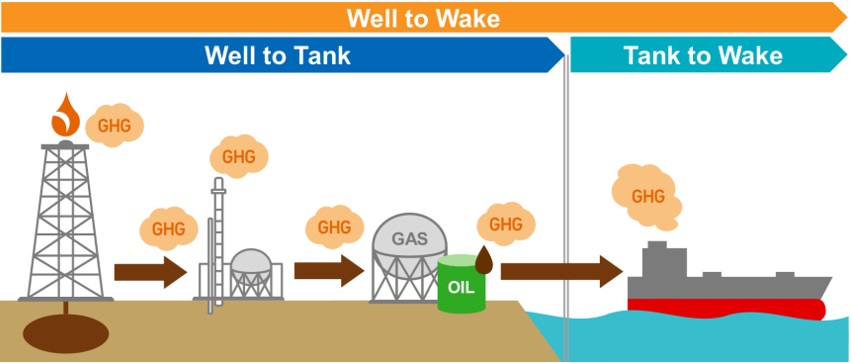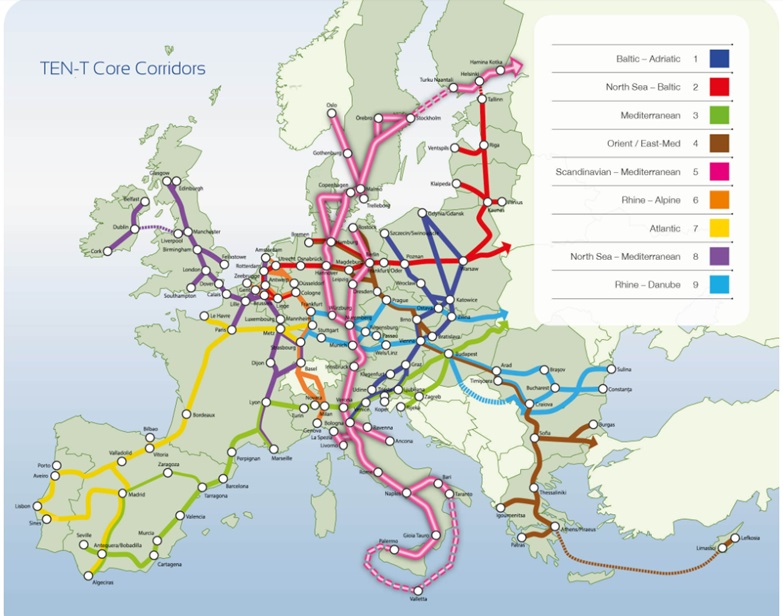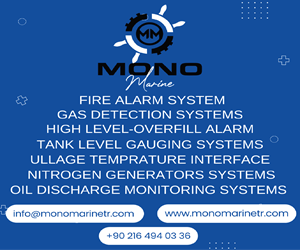How to Choose the Right Strategy for Fuel and Engine Selection...
How to Choose the Right Strategy for Fuel and Engine Selection in Accordance with the Fuel EU Maritime Directive?
In the previous article, we discussed how ships sailing to the EU will be affected by the Fuel EU Directive in order to achieve the 2050 carbon neutral target. It was also mentioned that especially for companies operating intensively to the EU ports, the Fuel EU Directive will bring a much higher financial burden compared to the EU ETS. In this article today, I will focus on how alternative fuels will provide the target value according to Fuel EU Directive 2023/1805.
As it is known, both the Fuel EU and IMO MEPC 81 regulations necessitate the use of low-carbon fuels and/or fuels that use renewable energy sources in the production and supply process, using the same methodology. The Fuel EU Directive covers ships of 5000 GT and above.
To summarize briefly:
- In the calculation of target value of carbon emissions, it takes into account not the CO2 emissions per MT, unlike the CII calculation, but the equivalent CO2 emissions per MJ. Equivalent CO2 emission per MJ is specified as GHG Intensity (gCO2eq/MJ).
- Target GHG Intensity changes every 5 years, and shipping companies are expected to meet these target values. The base value is 91.16 gCO2eq/MJ. The target values to be determined for the target value decrease aggressively in the coming years. The table-1 below shows that the annual reduction targets will become more ambitious up to 2050.
Table-1.The target GHG Intensity values for every five-year period starting from 2025

- Equivalent CO2 values consist of the sum of CH4 (Methane) and N2O (Nitrous oxide) components in addition to CO2.
- The calorific values of fuels are also important in the calculations.
- Unlike the CII calculation, it does not only take into account the CO2 emissions released into the atmosphere by combustion in ship engines (TtW-Tank to Wake), but also the equivalent CO2 emissions released into the atmosphere during the production and supply chain processes (WtT-Well to Tank). It covers all equivalent CO2 values in the fuel's life cycle (WtW-Well to Wake). In summary, the equivalent CO2 value released to the environment throughout the fuel's life cycle (WtW)
GHG〗_e [g〖CO〗_2eq ]=WtT (fuel, electricity)+TtW (Combustion, slip)
Figure-1. Well to Wake Methodology covers Welll to Tank and Tank to Wake CO2 emissions

(Source:https://www.classnk.or.jp/hp/pdf/infoservice/ghg/Pathwayto
ZeroEmissioninInternationalShippingClassNK_EN.pdf)
The difference between CII rate and Fuel EU-MEPC 81 calculations for vessels of 5000 GT and above within the scope of 2050 targets also contains a contradiction. This contradiction needs to be eliminated especially when the MEPC 81 enters into force. Let's try to explain this contradiction as follows:
Let's consider a company that has made the necessary conversion to burn hydrogen on its ships in accordance with the Fuel EU Directive. The cheapest alternative for the hydrogen used will be the fuel type obtained by carbon capture from natural gas. In the case of hydrogen use, zero carbon emission is released according to the CII rate calculation. In this case, what is the situation of hydrogen, which we define as clean energy, according to the Fuel EU application? The table-2 shows the WtT (CO2eq, WtT) and Equivalent CO2 values of different fuels at the WtT stage. It should be noted that Fossil Hydrogen (gray Hydrogen) has the highest WtT emissions. Gray Methanol has the second highest WtT emissions.
Table-2 WtT equivalance CO2 and TtW emissions factors for per ton fuel consumption

If we look at the table-3, according to Fuel EU directive, the WtT GHG density of HFO, Fossil methanol and Fossil H2 is as follows:
Table-3. Comparison of GHG Intensity values of methanol fuel with fossil fuels used intensively by ships

Let’s calculate the ship Compliance Balance and the reward-penalty status according to the calculated GHG Intensity values. The target GHG intensity in 2025 is 89.3 gCO2eq/MJ. The table-4 shows fuel penalties of different fossil Fuels.
Table-4. Fuel penalties of different fossil fuels

According to the CII calculation, a ship with an efficiency class of "A", when calling at EU ports and using the same fuel, suddenly becomes the fuel type that pollutes the environment the most and is subject to the highest penalties according to the "Fuel EU Directive". If the IMO and the EU want to combat global warming effectively, they will have to harmonize the CII and Fuel EU metrics instead of allowing them to contradict each other.
The same applies to ships over 400 GT. Let's assume that a ship using hydrogen obtained from natural gas generates electricity with a fuel cell and transfers this energy the propulsion sytem via PTI or to an directly electric propulsion system. In this case, since the Fuel EU application covers 5000GT and above, a company that decides on a structural transformation in new construction ships of 400 GT and above is seen to have built an environmentally friendly ship, while according to the WtT method used in the Fuel EU directive, it releases about 10 times more carbon into the atmosphere than MDO although it is shown to be more environmentally friendly according to AER metric. While bio or e-hydrogen seems like a solution, these fuels are not feasible in the medium term as their total cost is much higher than MGO and HFO fuel cost including fuel penalty.
A similar situation applies to methanol obtained from coal or natural gas. Engine manufacturers create the perception that gray methanol is more environmentally friendly by calculating only on the basis of carbon emissions per MT, regardless of the calorific value of the fuel. However, when the fuel consumption is taken into account according to the equivalent energy value of HFO or MGO, the carbon factor, which is seen as 1.375, increases to 3.20. As a result, even the WtT CO2 emission reaches the MGO level. The methanol price equivalent to MGO also reaches from the level of about 300$ to the level of 700$. In the case of using gray methanol, more fuel penalty is paid than HFO, LFO and MGO, and when fuel prices are calculated according to equivalent MGO or HFO, they reach the same price level as fossil fuels or even slightly higher. In case of switching to bio methanol, the ship, which sails without paying any penalty between 2025-2030, is penalized again after 2030.
Among alternative fuels, it is understood that the appropriate starting point is Gray LNG. Here, the question of which main engine type should be chosen is important. Let's assume for a moment that we convert a 4-stroke diesel engine to LNG and choose a DF (dual fuel) main engine operating on a four-stroke diesel cycle in the first construction. In this case, unfortunately, the company will have made the wrong choice. However, when the company chooses a DF LNG engine operating on a 2-stroke dual-fuel diesel cycle, it makes the right choice. Due to the high methane slip in four-stroke engines, GHG intensity cannot meet target values. Due to the relatively high methane slip value in 2-stroke low Speed DF LNG engines operating on the Otto cycle, they will be penalized after 2035.
It is understood that Gray LNG is the appropriate starting point among alternative fuels for ships that frequently sailed EU ports for the 2050 carbon neutral target. Here, the question of which main engine type should be chosen is of great importance. Let's assume for a moment that we convert a 4-stroke diesel engine to LNG and choose a DF (dual fuel) main engine operating on a 4-stroke diesel cycle engine during initial construction. In this case, unfortunately, the company will have made the wrong choice. However, if the choice is made in favor of a DF LNG engine operating on a 2-stroke diesel cycle, the correct choice will have been made. Since the methane slip is high in four-stroke engines, the GHG intensity target values cannot be achieved. Due to the relatively high methane slip value in 2-stroke slow Speed DF LNG engines operating on the Otto cycle, they will be subject to penalties after 2035. The table below shows the penalty and reward statuses of different fuels.
Table-5. Different DF engines and their penalty status

When LNG is used as a fuel, it will result in a positive balance in the account instead of a penalty. As a result, a newly built ship using an LNG-burning main engine will be able to continue its commercial activities without any problems until 2040. Assuming that prices will fall to a more reasonable level in 2040 and beyond, it seems possible to continue using Bio LNG or e-diesel with low WtT emissions. The table below shows the tank capacity requirement, penalty-reward status, and total LNG cost for a ship using Gray LNG, depending on the range. The calculation assumes a Ro-Ro ship traveling from a non-EU country to an EU country at a speed of 16 knots and consuming 39 MT per day.
The EU AFIR Regulation (Alternative Fuels Infrastructure Regulation )mandates EU Member States to establish LNG bunkering points in TEN-T ports (Figure-2). This regulation makes the use of LNG fuel more attractive for ships that frequently sail to the EU ports. LNG bunkering points are facilities where ships can refuel with LNG.
Figure-2 AB TEN-T Main Port and Routes. (Source:https://www.portnews.it/en/european-observatory/radar/trans-european-transport-network/)

Conclusion
Key Points for Ship Operators Trading Frequently to the EU.
- Shipping companies that frequently trade to the EU should avoid making incorrect strategic decisions based on projects supported by EU and national funds.
- In the short term, grey methanol is not feasible as it will result in higher penalties compared to HFO, LFO, and MGO.
- Bio-methanol and e-methanol prices are expected to be significantly higher than HFO-VLSFO prices in the medium term, making them less viable.
- The EU and IMO need to address the inconsistencies between CII calculations and Fuel EU calculation metrics. At the very least, a correction factor should be added to the Attained CII formula for fuels produced according to the RED directive to align it with the Fuel EU metric.
- Considering the AFIR regulation, shipping companies that frequently trade to the EU should focus on LNG-fueled vessels in the medium term. However, careful consideration should be given to the type of engine used.
Additional Considerations
- The availability of LNG bunkering infrastructure is crucial for the widespread adoption of LNG as a marine fuel.
- The cost of LNG fuel and the availability of incentives for LNG-fueled vessels will also impact the adoption of this technology.
- Ship operators should carefully evaluate the specific requirements of their operations and the regulatory landscape before making investment decisions.

















YAZIYA YORUM KAT
Türkçe karakter kullanılmayan ve büyük harflerle yazılmış yorumlar onaylanmamaktadır.